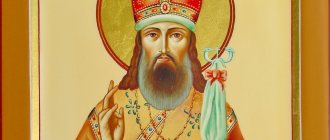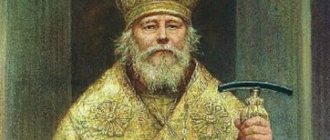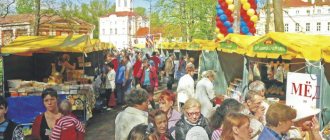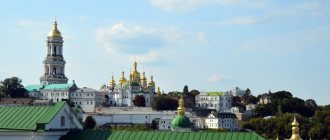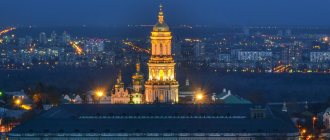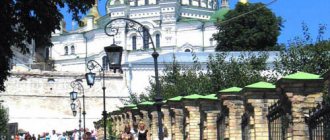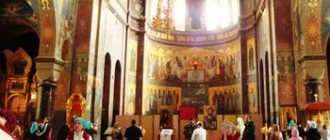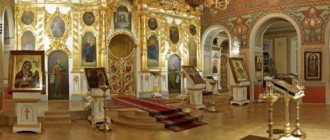Saints Reverend Vassa and Jonah of Pskov-Pechersk
“Life of Sts.
Ionna and Vassa of Pskov-Pechersk” listen... The gospel words that husband and wife are “one flesh” are perfectly suited to our next heroes.
The life path of the Venerable Vassa is closely connected with the feat of the Venerable Jonah , the founder and builder of the Pskov-Pechersk monastery in honor of the Dormition of the Most Holy Theotokos, before the tonsure of the priest John, her husband. All the hardships and suffering that the priest had on his thorny path were also her torments. Brief information about Saint Vassa and her wife is provided by the “Tale of the Pskov-Pechersk Monastery.” The Monks Vassa and Jonah (in the world Mary and John) lived in the 15th century; Mary’s husband, Father John, came “from the Moscow land,” for which the Pskovites nicknamed him Sherstnik, that is, an alien. Mother Maria was full of selflessness in the name of love for her husband, children and neighbor. But above this she had a love for the Lord. She, fearless, uncomplaining in any danger, tireless in work and love, and indestructible in suffering, lived according to the word of the Apostle: “Let the hidden man be your adornment in the imperishable beauty of the spirit.” Her whole life belonged to her husband, a servant of the Throne of the Lord. By the providence of God, Father John, together with his mother and children, arrived in the Livonian city of Yuriev (Tartu) in the second half of the 15th century. “Seeing the glorious life,” is sung in the akathist of the Pskov-Pechersk Reverend, “and the patience of your husband, you were not afraid of your labors and exploits, O Reverend Mother Vasso... Rejoice, you who shared pastoral sorrows and persecutions from the Latins in Dorpat with your husband...” (Ikos 5 ). Indeed, the anger of the Catholic clergy and Livonian knights towards Orthodoxy and its followers was so fierce that the family of the priest John was forced to live in 1470 - 1471. flee to the nearest city of Pskov, and Presbyter Isidor, who remained in Yuryev, and 72 other people with him, soon suffered martyrdom - on January 8, 1472, Catholics threw them under the ice of the Omovzha River (modern name - Emajõga). (Father Isidore was later canonized by the Russian Orthodox Church as a holy martyr). The chronicler testifies that, having arrived in Pskov, Father John with his wife and two children took up a new task. Having heard about the discovery of a “God-created cave” not far from the Livonian border, near the Kamenets stream, the priest looked at it as a possible place for his future penitential monastic labors and went there. The family settled in a small village with the peasant Ivan Dementyev near the Pachkovka River. Father John got up early in the morning, while it was still dark, and went to the Holy Mountain, where he was digging a church to the west of the open “God-made cave.” Although the chronicle does not contain detailed information about what his wife and children were doing, there is no doubt that they helped Fr. John in his difficult labors. Having completely taken upon herself the upbringing of children and running the household, Mother Vassa planted the seeds of Truth and goodness in the souls of her children, and, living her life in the fear of God, she raised her children in the same way, preparing to give an account to God for them. After some time, Mother Maria fell ill and took monastic vows with the name Vassa (in some editions of the Tale ... - Vasilisa), (the meager lines of the story tell that “shortly his wife (Fr. John) fell ill and was tonsured became a monk, and she was given the name Vassa, and reposed in the same image.” Mother Vassa was, according to the Chronicle, the first person in the history of the Pskov-Pechersk Monastery to take on the monastic image there. The first miracle happened over her in this monastery at the very beginning of its foundation. When nun Vassa died, a grave was prepared for her in a “God-created cave.” Although initially her husband tried to bury Vassa in a grave he dug with his own hands. “...John dug up the earth in that “God-created cave,” and with her spiritual father laid a gravestone in it. In that night, something was brought out of the earth by some invisible force,” says the Tale of the Lives of Saints Vassa and Jonah. But the next morning the coffin with the body of Saint Vassa found itself on the surface of the earth. This miracle greatly amazed Fr. John and her confessor, not to mention those who saw off nun Vassa on her last journey. The chronicler says: “John, having thought with her spiritual father that he had sinned something in the gravestone, and having sung the second service, and uttered a prayer of permission to her father, buried it again, and on the second morning he was found, found on the top of the earth. John, perplexed by this, excavated a place on the left side of the cave, and laid her coffin unburied.” (Tale, p. 5). (Translation: “The next night after the nun was buried, her coffin was pulled out of the ground by some invisible force. Father John and Vassa’s spiritual father, thinking that they had missed something in the funeral chant, performed this on the deceased singing a second time and after a prayer of permission, they lowered her into the same grave again. But a night later, Vassa’s coffin again found itself on top of the grave. After that, John left her coffin unburied and placed it on the left side, at the entrance to the cave, digging it in the wall only the container needed for it." (First-class Pskov-Pechersky Monastery. Island, 1893, pp. 7-8)). Thus, immediately after her repose, God glorified the Venerable Vassa, and after many years a great miracle was revealed again - during one of the attacks of the Livonians on the Pskov-Pechersk monastery, a certain knight boldly intended to desecrate the holy tomb with the relics of the saint. He tried to open the lid of the coffin with a sword, but was suddenly hit by Divine fire emanating from within. On the right side of the coffin there was a trace of flame, sometimes fragrant and emitting a wonderful aroma to this day. The fact that Saints Vassa and Jonah have long been venerated in the monastery is evidenced by the mention in the “Tale...” of the transfer of the relics of Saint Vassa (along with the old dilapidated coffin) to a new coffin, which took place on March 7, 1600, along with the relics of the first Pskov-Pechersk monks - Saints Mark (late XIV - early XV centuries) and Jonah. The Venerable Mother Vassa, as we have already said, became the first person to take monastic vows at the monastery, and for her godly and blessed life she was honored with heavenly palaces, together with the elder Mark the desert dweller and with her husband, the Venerable Jonah. The life of the venerable spouses Jonah and Vassa is one of those lives that from beginning to end is the glorification of the name of God. The life of the world, often cruel and seemingly meaningless, becomes wise and beautiful in the light of the saints - the great bearers of God's Truth on earth. Their life is the overcoming of evil by a feat of love, the appearance of Heaven on earth. Saints Reverend Jonah and Vassa are revered today in Rus' as patrons of marriage, along with Saints Peter and Fevronia of Murom.
President's visit
The caves maintain a year-round temperature of plus 7 degrees and high humidity. There is sand under your feet, you walk on it like on a soft carpet with a candle in your hand. Without a guide, you can get lost in the cave streets and galleries - there are seven of them. There is also an underground temple in honor of the Resurrection of Christ as a sign of the general resurrection, when dead bodies will rise from their graves, acquire an incorruptible appearance and unite with their immortal soul. The late elder Archimandrite John (Krestyankin) , buried in the Holy Caves in 2006, called on pilgrims to “enter the silence of the caves” to fill their hearts with “unearthly feelings.” Here, in the underground cemetery, there is no place for fear and despondency, although the coffins are here, at arm's length, and many can be touched. In the Holy Caves, the coffin with the body of the deceased is placed in one of the niches in the wall. At the same time, there is no smell of decay, which surprised President Boris Yeltsin , who visited the monastery in the fall of 1994.
He asked: “What do you smear them with?” “Nothing,” answered the monks. “This is a miracle of God.” But the president did not calm down, then he was asked: “Is there anyone around you who smells bad?” - "Of course not". - “So do you really think that someone will smell bad when surrounded by the Heavenly Father?” Related article Has not been closed for 540 years. What attracts pilgrims to the Pechersk Monastery
Righteous Father Alexy Mechev
Righteous Father Alexy Mechev with his family In an incomparably smaller volume, but still history has preserved the correspondence of another saint of the 20th century - Righteous Father Alexy of Moscow (Mechev), a perspicacious Moscow elder - with his wife Anna Petrovna Molchanova. “I fully believe that you are a deeply religious person, pray for me, my angel, so that I too will be one,” the future elder writes to his wife. Both of them came from families of priests, they got married at almost a young age (Anna had just turned 18) and lived unusually happily until her death at the age of 36. In the surviving letters of Father Alexy to his wife, which he wrote while he was away, there is tenderness, delicacy, care and great love: Your husband “even though he is 25 miles away from you, my precious, but knows well, clearly and feels that you you think and do...” “My golden sun...”; “My dear beauty... precious little wife Nyushenka... my life, take your medicine and drink more milk”; “Forget about everything in the world, think only that you get better quickly, take comfort in the thought that your husband is constantly thinking about you”; “Even though he is 25 miles away from you, my precious, he knows and feels well, clearly, what you think and do...” Five children were born into the family. Anna Petrovna, suffering seriously from illness, asked her husband to stop begging her. And he listened to her - out of great love and pity. On August 29, 1902, on the day of the Beheading of John the Baptist, Mother died. And for Father Alexy, whose grief was immeasurable, the path of eldership will soon open: with his experience of love and sorrow, he will enter into the sorrow of thousands of people who will flock to the Moscow priest from all over Russia.
Venerable Seraphim Vyritsky
Vasily and Olga Muravyovs with their son Even more amazing is the story of the spouses Vasily and Olga Muravyovs. They are better known to the Orthodox world as schema-nun Seraphim and elder Seraphim Vyritsky. Both had dreamed of monasticism since childhood, but the confessor of the future elder gently rejected this desire of Vasily for a while, saying that he still needed to get married and live a difficult worldly life. The couple was engaged in commerce and charity; at the beginning of the 20th century, Vasily Muravyov was one of the richest people in Russia. They donated huge sums for monastery and temple construction, fed and clothed the poor for free, maintained and themselves visited several almshouses. The couple had two children. But the death of their daughter becomes a kind of milestone for them: with the blessing of their confessor, they begin a kind of preparation for monasticism, at first still living together, but as brother and sister. And after 30 years of a happy marriage, they go their separate ways... only to meet again in old age. In the elder’s cell there hung a picture – the grave of schema-nun Seraphima, his wife in the world. It was both a mortal memory and a memory of a friend. At the end of the 1930s, the health of Schemamonk Seraphim, who by that time had become the confessor of the Alexander Nevsky Lavra, deteriorates so much that the abbot calls Mother Seraphim with orders to take the elder to the village. Mother looked after Father Seraphim until the end of her days; she herself was a great ascetic, praying at night, and was the first to pass into eternity. Some of the visitors to the perspicacious elder recall that when he could no longer get out of bed, in his cell there hung a picture depicting the grave of his wife in the world - schema-nun Seraphima. It was both a mortal memory and a memory of a friend with whom, by God’s Providence, they were inseparable even after tonsure.
Tsar Nicholas and Tsarina Alexandra
All the arts in the world glorify love and passion, but few people manage to carry a tender, loving relationship through their entire lives. The last Russian emperor and his wife became such a rare example. Reading their correspondence from 1894, we are not surprised at the abundance of tender words: they are the bride and groom, separated and in a tense situation when their marriage might not have taken place, because Emperor Alexander III was initially against him. But here they are - husband and wife for 20 years, they have five children, and the letters from this period - letters of mature love - evoke surprise and admiration. “Tomorrow morning at 9 o’clock I’ll go to church, I’ll try to go there on Thursday as well. Praying for you is my joy when we are separated. I can’t get used to being without you in the house even for the shortest time, although I have our five treasures with me. Sleep well, my sunshine, my precious one, - your old Wife sends you a thousand tender kisses. May God bless and keep you!” “Praying for you is my joy when we are separated. I can’t get used to being without you even for the shortest time...” “My beloved, I kiss you often, often, because now I am very free and have time to think about my wife and family. It's strange, but it's true. I hope you're not suffering from that nasty jaw pain or overworking yourself. God grant that my little one will be completely healthy when I return! I hug you and tenderly kiss your priceless face, as well as all my dear children. I thank the girls for their sweet letters. Good night, my dear Sunshine. Always your old hubby Nicky.” According to etiquette, Nikolai and Alexandra were supposed to behave rather coldly in public, and only personal correspondence, which relatively recently became public knowledge, could show the atmosphere of this family. It is not surprising that at the last moment of earthly life the Lord vouchsafed them to be together.
Martyred Spouses
Apostle Aquila and his wife Priscilla Ancient times are replete with examples of Christian martyrdom, so it is not surprising that some of the first celebrated spouses were martyrs. This is the Apostle Aquila - Bishop of Heraclea, disciple of the Apostle Paul - and his wife Priscilla, who preached together in Asia, Achaia, Heraclia and were killed by the pagans. These are the martyrs Zoe and Esper, who were slaves and tortured for their faith along with their sons Cyriacus and Theodulus during the persecution of Emperor Hadrian in the 2nd century. These are the holy martyrs Terentius and Neonilla of Syria and their seven children: they lived in the 3rd century and were tortured and eventually beheaded for their fearless confession of Christ. This is the martyr Chrysanthus and his wife Daria, who married a pagan priestess, but accepted her husband’s faith. By mutual consent, they decided on a virtually monastic lifestyle and, being married, lived as brother and sister - and were tortured and buried alive in the ground by the pagans. These are the spouses Adrian and Natalia of Nicomedia - in their family, on the contrary, the husband believed after his wife. As an official, he personally included himself in the list of Christians sentenced to death for their faith in Christ, and was subjected to a painful execution. But Natalia, even though she was not touched, is revered as a martyr. Before her eyes, Adrian was tortured, and his wife strengthened him, and after his death she refused to remarry and soon after that she died at the coffin of her husband. Both were no more than 30 years old. Modern times provide us with the same examples of martyrdom as the first centuries of Christianity. Thus, Archpriest Vladimir Dzhurinsky (1885–1920), rector of the church in the village of Sergeevka, Semirechensk region, and his wife Euphrosyne (1888–1920) ended their lives together, without renouncing Christ. They were shot in the city of Verny (today Alma-Ata). But if there is almost no information left about many martyrs and their lives, then today we can see all the beauty of the marriage of one glorified saint couple in the surviving correspondence and diaries. Of course, these are the holy royal passion-bearers Emperor Nicholas and his wife Alexandra.
